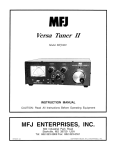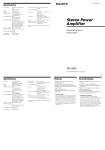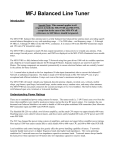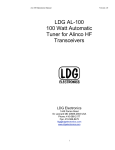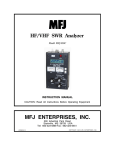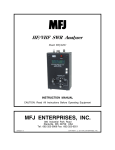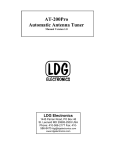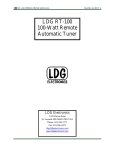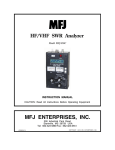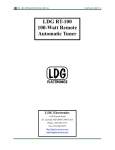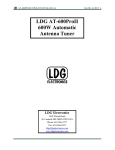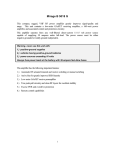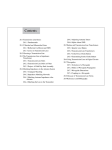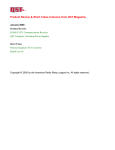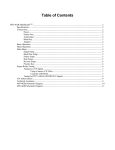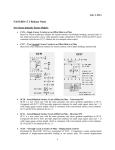Download MFJ-269CPRO User Manual
Transcript
Model MFJ-269CPro INSTRUCTION MANUAL CAUTION: Read All Instructions Before Operating Equipment MFJ ENTERPRISES, INC. 300 Industrial Park Road Starkville, MS 39759 USA Tel: 662-323-5869 Fax: 662-323-6551 VERSION 1A COPYRIGHT C 2014 MFJ ENTERPRISES, INC. MFJ-269C-Pro Instruction Manual LF/HF/VHF/UHF SWR Analyzer TABLE OF CONTENTS 1.0 2.0 3.0 4.0 5.0 INTRODUCTION 2 1.1 TYPICAL USE 2 1.2 FREQUENCY RANGE 3 1.3 ACCURACY NOTES 3 POWER SOURCES 4 2.1 EXTERNAL POWER SUPPLY 4 2.2 INTERNAL BATTERIES 5 2.3 RECHARGEABLE BATTERIES 5 2.4 USING CONVENTIONAL “AA” DRY CELL BATTERIES 6 2.5 “VOLTAGE LOW” DISPLAY WARNING 6 2.6 SLEEP MODE “POWER SAVING” 6 MAIN MENU AND DISPLAY 7 3.1 GENERAL CONNECTIONS 7 3.2 POWER-UP DISPLAY 7 3.3 MAIN MEASUREMENT MODES (LF/HF/VHF, 0.53-230 MHZ) 8 3.4 FREQUENCY CONTROL 9 MAIN (OR OPENING) MODE 10 4.1 GENERAL CONNECTIONS 10 4.2 ANTENNA SWR AND IMPEDANCE 10 4.3 COAX LOSS (FUNCTION-2) 12 4.4 CAPACITANCE (FUNCTION-3) 13 4.5 INDUCTANCE (FUNCTION-4) 14 4.6 FREQUENCY COUNTER (FUNCTION-5) 15 ADVANCED OPERATION 15 5.1 FORWARD 15 5.2 ACCESSING ADVANCED MODES 16 5.3 GENERAL CONNECTIONS 17 5.4 ADVANCED -1 MODES 17 5.5 ADVANCED- 2 MODES 23 5.6 ADVANCED 3 (LF/HF/VHF ONLY) 29 ii MFJ-269C-Pro Instruction Manual 6.0 7.0 8.0 LF/HF/VHF/UHF SWR Analyzer ADJUSTING SIMPLE ANTENNAS 30 6.1 DIPOLES 30 6.2 VERTICALS 31 6.3 TUNING A SIMPLE ANTENNA 31 TESTING AND TUNING STUBS AND TRANSMISSION LINES 31 7.1 TESTING STUBS 31 7.2 VELOCITY FACTOR OF TRANSMISSION LINES 32 7.3 IMPEDANCE OF TRANSMISSION LINES OR BEVERAGE ANTENNAS 33 7.4 ADJUSTING TUNERS 34 7.5 ADJUSTING AMPLIFIER MATCHING NETWORKS 35 7.6 TESTING RF TRANSFORMERS 35 7.7 TESTING BALUNS 35 7.8 TESTING RF CHOKES 36 TECHNICAL ASSISTANCE 37 iii MFJ-269C-Pro Instruction Manual LF/HF/VHF/UHF SWR Analyzer ATTENTION: READ SECTION 2.0 BEFORE ATTEMPTING TO USE THIS PRODUCT. INCORRECT POWER SUPPLY VOLTAGES OR EXCESSIVE EXTERNAL VOLTAGES APPLIED TO THE ANTENNA CONNECTOR WILL DAMAGE THIS UNIT. 1.0 INTRODUCTION The MFJ-269C-Pro is a compact battery powered RF impedance analyzer especially designed for professional field work. It combines five basic circuits; a variable oscillator, frequency counter, frequency multiplier, 50-ohm RF bridge, twelve-bit A-D converter, and a microcontroller. Together, these circuits perform a wide variety of useful antenna and RF impedance measurements including coaxial cable loss and electrical distance to an open or short. Although mainly designed for analyzing 50-ohm antenna and transmission line systems, the MFJ-269CPro also measures RF impedance from a few ohms to several hundred ohms. An easy-to-access usercontrolled Zo setting in the Advanced function menus facilitates changing SWR and other SWR functions (i.e. return loss, reflection coefficient, match efficiency, etc) to any normalized impedance value between 5 and 600 ohms. The MFJ-269C-Pro also functions as a non-precision signal source and frequency counter. Operating frequency extends from 0.53 to 230 MHz in nine overlapping bands with extended SWR measurement from 415 to 520 MHz. (LF coverage may be adjusted to cover 0.470 kHz). 1.1 Typical Use The MFJ-269C-Pro may be used to adjust, test, or measure the following: Antennas: ...................................SWR, impedance, reactance, resistance, resonant frequency, and bandwidth Antenna tuners: ..........................SWR, bandwidth, frequency Amplifiers: .................................Input and output matching networks, chokes, suppressors, traps, and components Coaxial transmission lines: ........SWR, length, velocity factor, approximate Q and loss, resonant frequency, and impedance Filters: ........................................SWR, attenuation, and frequency range Matching or tuning stubs: ..........SWR, approximate Q, resonant frequency, bandwidth, impedance Traps: .........................................Resonant frequency and approximate Q Tuned Circuits:...........................Resonant frequency and approximate Q Small capacitors: ........................Value and self-resonant frequency RF chokes and inductors:...........Self-resonant frequency, series resonance, and value Transmitters and oscillators: ......Frequency The MFJ-269C-Pro measures and directly displays the following: Electrical length (feet or deg) Feedline Loss (dB) Capacitance (pF) Impedance or Z magnitude (ohms) Impedance phase angle(degrees) Inductance (μH) Reactance or X (ohms) Resistance or R (ohms) 2 Resonance (MHz) Return loss (dB) Signal Frequency (MHz) SWR (Zo programmable) MFJ-269C-Pro Instruction Manual LF/HF/VHF/UHF SWR Analyzer The MFJ-269C-Pro is also useful as a non-precision signal source. It provides a relatively pure (harmonics better than -25 dBc) signal of approximately 3 Vpp (~20 mW) into a 50 ohm load. The internal source impedance is 50 ohms. Although not "stabilized", it provides adequate stability for noncritical applications such as alignment of broad-bandwidth filters and circuits. Note: For a more complete description of features and test methods, consult the table of contents to find the manual sections describing the particular measurement you wish to make. 1.2 Frequency Range The unit's dual-range Frequency switches select the following oscillator bands with a small overlap: 0.53-1.0 MHz 1.0-2.1 MHz 2.1-4.7 MHz 4.7-11.0 MHz 11-28 MHz 28-67 MHz 67-113 MHz 113-155 MHz/UHF LO* 155-230 MHz/UHF HI* *A UHF pushbutton switch located above the LCD display activates 415-520 MHz SWR coverage. See section 3.4 for VFO operating specifics. 1.3 Accuracy Notes If measurement errors occur, they will likely be caused by one of the following conditions: 1. Signal ingress from external sources, usually from a strong AM broadcast station. 2. Diode detector and A/D converter error. 3. Stray impedance errors contributed by connectors, cables, and adapters. Broad-band Voltage Detectors and External Interference: Laboratory grade network analyzers use expensive high-selectivity gain-stabilized receivers to avoid off-frequency interference and ensure measurement accuracy. Building these sophisticated detectors into the MFJ-269C (or any small handheld unit) would drive the price far beyond the reach of most hobbyists. As an alternative, we use broadband detectors that provide accurate measurements at a much lower cost. The only drawback is that broadband detectors can be sensitive to powerful out-of-band signals. Most of the time, out-of-band interference isn't an issue, but occasionally a particularly powerful signal may be picked up by the antenna under test and routed into the analyzer bridge circuit where it conflicts with the internally generated VFO signal. When strong "signal ingress" such as this occurs, it may result in inaccurate readings. The solution for out-of-band interference isn't simple. Increasing the analyzer's generator power would help, but doing so causes the unit to draw significantly more power at the expense of reduced battery operating time. Higher power may also cause on-air interference when testing antenna systems that radiate efficiently or exhibit directivity gain. Using common low-pass or band-pass filters similar to those used in transceivers also wouldn't work because they behave like transmission lines of varying impedance on different frequencies. Using them would only introduce gross measurement inaccuracies. MFJ-731: Fortunately, most analyzer interference problems occur on the lower frequencies, with near-by high power AM broadcast signals being the worst offender. When testing physically large antenna arrays such as 160-meter verticals, these powerful outside signals may couple very efficiently into the analyzer's bridge circuit. Other strong local HF signals may "get in" as well. To correct the problem, we offer the 3 MFJ-269C-Pro Instruction Manual LF/HF/VHF/UHF SWR Analyzer MFJ-731 tunable filter, an accessory especially designed to attenuate off-frequency signals. The MFJ-731 permits accurate impedance measurements between 1.8 and 30 MHz with virtually no impact on measurement accuracy. Detector Errors: At low voltages, detector diodes become non-linear. To address this issue, the MFJ269C-Pro uses special microwave zero-bias Schottky detectors with matched compensating diodes. Each unit is individually compensated to provide the best detector linearity possible. Small errors may also occur during A/D conversion due to practical limitations on bit resolution. Connection lengths: Connection lengths both inside and outside the analyzer bridge can upset readings, especially at higher frequencies and when impedance is very high or very low. The MFJ-269C-Pro minimizes internal problems by using surface mount low capacitance microwave components with nearly zero lead length. It's important to remember that any external leads you add, even short leads, will modify the impedance of the load at radio frequencies. To obtain highest accuracy, always use the shortest test cables possible with the fewest connectors and adapters in the line. Note: Some handheld analyzers display erroneous readings falling outside the reliable measurement range, presenting that data numerically -- as if it were "factual". The MFJ-269C-Pro is designed to avoid such errors by displaying an on-screen warning (Z > 1500) anytime data falls outside the unit's accurate measurement range. 2.0 POWER SOURCES This section describes power supply and battery selection. READ THIS SECTION BEFORE CONNECTING THIS DEVICE TO ANY POWER SOURCE. IMPROPER CONNECTIONS OR INCORRECT VOLTAGES MAY CAUSE DAMAGE TO THIS PRODUCT! 2.1 External Power Supply The MFJ-1312D satisfies all external voltage and current power source requirements and we highly recommend using it with your MFJ-269C-Pro. External power requirements are as follows: 1. When the unit is ON, supply voltage must be over 11 volts but not exceeding 16 volts. 2. When in Sleep Mode or OFF (supply lightly loaded), voltage must not exceed 18 volts. 3. The supply must be well filtered against hum and noise. 4. The MFJ-269C-Pro case (ground) must be connected directly to the supply's negative terminal. 5. The supply must not have a grounded positive lead (- center pin). 6. The "ideal" supply voltage is 13.8 volts dc. 7. When rechargeable batteries are used, 13.8 volts is required for charger operation. 8. Current demand is 150 mA (max) on HF and VHF, 250 mA (max) on UHF. WARNING: READ SECTION 2.2 THROUGH 2.4 (BATTERY INSTALLATION INSTRUCTIONS) BEFORE INSTALLING BATTERIES. 4 MFJ-269C-Pro Instruction Manual LF/HF/VHF/UHF SWR Analyzer The MFJ-269C-Pro has a recessed 2.1 mm power receptacle near the RF connectors. This receptacle is labeled POWER 13.8 VDC. The outside conductor is negative, the center is positive. Inserting a power plug in the POWER 13.8 VDC receptacle disables internal batteries as the analyzer's power source. However, the internal batteries will still be trickle charged when the power supply plug is inserted into the unit. Power plugs must be wired as shown below: + + - WARNING: 2.2 2.1 mm REVERSE POLARITY OR EXCESSIVE VOLTAGE CAN DAMAGE THE MFJ-269C-PRO. NEVER APPLY MORE THAN 18 VOLTS, NEVER USE AC OR POSITIVE GROUND SUPPLIES! NEVER ADD OR REMOVE BATTERIES WITH AN EXTERNAL POWER SUPPLY CONNECTED TO THIS UNIT, OR WITH THE POWER SWITCH ON. Internal Batteries When installing internal batteries, first check the position of a small black-plastic internal jumper plug that controls charger operation. The jumper is located inside the unit at the top of the printed circuit board near the area of the OFF-ON switch and power connector. To access it, remove all eight screws on the sides of the case and remove the back cover. The black plastic jumper fits over two of three adjacent pins (see detailed instructions below). The plug must be properly positioned for the type of cell you plan to use (AA rechargeable or AA non-rechargeable). 2.3 Rechargeable Batteries Important Note: When using rechargeable batteries, your external power source must deliver at least 14 volts. If supply voltage is too low, the charger can't function and batteries will eventually discharge. If batteries are depleted, charge with the analyzer power switch turned off -- it may take ten hours or more to fully restore depleted cells. Important Warning: Never change batteries with the power switch "On" or with an external supply plugged in -- permanent damage may result. Always remove batteries when shipping the analyzer or storing it for an extended period (more than a month). When using rechargeable batteries, the internal black plastic jumper must be set to the proper position. Remove the analyzer cover and locate the jumper on the pc board (near the power jack). Confirm that it is set correctly. If not, reposition as shown below: Again, when the Charger Jumper is ON and a 13.8 to 18 volt source is applied, the charger will be functional. Typical charging current is 10-20 mA. 5 MFJ-269C-Pro Instruction Manual 2.4 LF/HF/VHF/UHF SWR Analyzer Using Conventional “AA” Dry Cell Batteries When using non-reachable batteries, install only high quality alkaline cells in matched sets (same manufacturer and date code). Conventional zinc-based cells have a shorter shelf and service life, and they are also more prone to leakage. Also, to prevent leakage, remove weak alkaline batteries immediately. WARNING: WHEN USING NON-RECHARGEABLE BATTERIES, THE CHARGING SYSTEM MUST BE DEFEATED! IF YOU FAIL TO FOLLOW THIS WARNING, THE BATTERIES WILL LIKELY LEAK AND RUIN THE ANALYZER! When using non-rechargeable batteries, set the internal jumper as shown below: Never attempt to charge alkaline (or any other non-rechargeable cells) using the MFJ-269C-Pro internal charger circuit! 2.5 “Voltage Low” display warning When the analyzer's supply or battery voltage drops below 11 volts, a blinking Voltage Low warning will be displayed. Pressing Mode during a low-voltage warning will disable the on-screen alert and allow you to continue operating. However, measurements may not be reliable when operating the analyzer with insufficient supply voltage! 2.6 Sleep Mode “Power Saving” Typical current drain for the MFJ-269C-Pro is around 150 mA for HF operation (250 mA for UHF). Battery operating time is (by default) extended significantly through the use of Sleep Mode. Sleep mode reduces current drain to less than 15 mA when it is engaged during periods of non-activity. Power-saving is a default setting for the MFJ-269C-Pro unless you defeat it when you turn on the analyzer (instructions below). Normally, the analyzer's processor looks for manual activation of the Mode switch or for any change in Frequency greater than 50 kHz. If neither event occurs during any given three-minute interval, Sleep mode automatically kicks in and places the analyzer in standby. A blinking SLP message in the display screen lower-right corner indicates power-saving mode (see below): To pull the unit out of SLP, momentarily press either the Mode or Gate button to resume operation. 6 MFJ-269C-Pro Instruction Manual LF/HF/VHF/UHF SWR Analyzer To disable Sleep, first turn the unit Off and then press and hold the Mode button when reapplying power. Continue holding Mode until after the copyright message appears on the LCD screen, then release. If the “Power Saving” mode has been is successfully disabled, the message shown below will appear as soon as Mode is released. Sleep Mode is a default function and will reset automatically each time the analyzer is turned OFF. To restore Sleep, simply turn the analyzer Off and then On again. 3.0 WARNING: 3.1 MAIN MENU AND DISPLAY NEVER APPLY RF OR ANY OTHER EXTERNAL VOLTAGE TO THE ANTENNA PORT. THE MFJ-269C-PRO USES ZERO BIAS DETECTOR DIODES THAT MAY BE DAMAGED BY EXTERNAL VOLTAGES. ALSO, READ SECTION 2.0 BEFORE APPLYING POWER. INCORRECT SUPPLY VOLTAGE OR REVERSED POLARITY CAN CAUSE DAMAGE. General Connections The N-female Antenna connector on top of the unit is the primary RF-measurement connection. It is used for all functions except frequency counter measurements. The Power connector (2.1 mm) is described in section 2.0. Please read the power-source section carefully before attempting to operate the analyzer! Improper voltage application, the wrong battery charger setting, or reversed polarity could permanently damage your unit. The BNC Frequency Counter Input is for frequency counter measurements only. See section 4.5 for the counter's operating instructions. 3.2 Power-up Display Important Note: Before powering up the analyzer, check the status of the UHF switch located above the LCD window on the left. This switch must be in the "up" or in the Off position unless UHF operation is intended. Note: The following is a description of the basic opening (or default) menu used by the MFJ-269C-Pro. Your analyzer also has an advanced user section (5.0). When applying Power, a sequence of message screens appear on the LCD display. The first screen lists the software version (Ver): Be sure to have this number handy when referring technical questions about your analyzer to MFJ Customer Service: MFJ-269C Ver 14.14 7 MFJ-269C-Pro Instruction Manual LF/HF/VHF/UHF SWR Analyzer The second message shows the software copyright date: MFJ Enterprises (c) 2014 The third message is a voltage check. It displays the operating voltage, indicating battery condition or the voltage of your external power supply. The fourth and final screen is the first "working display" (Complex Impedance). The two analog panel meters also activate when the working display comes up. 3.3 Main Measurement Modes (LF/HF/VHF, 0.53-230 MHz) Momentarily pressing (or tapping) the Mode button after the first working display appears allows you to scroll through all five basic measurement modes provided by the MFJ-269C-Pro. The opening mode is Impedance R & X (resistance and reactance). As each new mode comes up, its title screen appears for about two seconds, and then the companion data screen appears. Each of the five Basic Modes are listed below: 1. Impedance R&X: This is the analyzer's "default mode", and it is the function most commonly used. The top line of the data screen displays Frequency in MHz and SWR, while the bottom line shows complex impedance where Rs equals the load's series resistive component and Xs shows the load's series reactive component. In this function, the analog SWR and Impedance Meters (Z) are also activeated. 2. Coax Loss: Pressing Mode once brings up the Coax Loss -- followed by the data screen. The top line shows Frequency in MHz and the bottom line displays Coax Loss in dB. 3. Capacitance in pF: The third mode displays Frequency in MHZ on the top line, followed by Xc (capacitive reactance) on the bottom line. The analog meter also shows reactance X. 4. Inductance in μH: The fourth mode, Frequency appears on top and XL (inductive reactance) on the bottom. Meter shows reactance (X). 5. Freq. Counter: The fifth function turns off the analyzer's internal oscillator and routes the input of the counter to the BNC connector labeled Frequency Counter Input. In this mode, the top line of the LCD display shows the measured Frequency in MHz and the counter's Gate Time in seconds. 8 MFJ-269C-Pro Instruction Manual LF/HF/VHF/UHF SWR Analyzer Important Note: Section-4 of this manual provides detailed instructions for using each of the five basic operating modes described above. To ensure accurate measurement and avoid the possibility of inadvertent damage, please read through this section carefully before operating the analyzer! 3.4 Frequency Control The MFJ-269C-Pro tunable RF-oscillator covers an exceptionally wide frequency span, using two rotary band switches for LF/HF/VHF coverage (.53-230 MHz) -- plus an additional pushbutton switch to activate UHF coverage (415-520 MHz) . ON UHF OFF FREQUENCY MHz 67-113 113-155 UHF LO 155-230 UHF HI 28-67 11-28 Lower Range 2.1-4.7 1.0-2.1 TUNE 0.53-1.0 4.7-11 1. LF, HF and VHF Operation: The Lower Range rotary switch selects four LF and HF bands (0.5311.0 MHz). The Upper Range switch selects 5 HF and VHF bands for 11-230 MHz coverage. Note that the Upper Range switch must be set fully clockwise to the Lower Range position for the lower-range band selector to function. The variable Tune control (VFO capacitor) provides a small overlap at each band edge to ensure gap-free tuning across the spectrum. *Note that LF coverage may be lowered to 0.470-0.940 MHz (or lower) for 600-Meters and select maritime services. To modify, (1.) adjust Tune fully counter-clockwise, (2.) remove the back cover (3.) Remove battery pack by removing Philips head screws and, (4.) using a 2-mm hex tuning wand, readjust inductor L12 while watching the frequency display. 2. UHF Operation: UHF coverage is broken into two bands. To measure UHF SWR (415-520 MHz), first press in the UHF switch located just above the LCD display. Then, for 415-470 MHz coverage, set the upper Frequency MHz switch to the 113-155 MHz band (UHF LO). For 470-520 MHz coverage, set the upper Frequency MHz switch to 155-230 MHz. (UHF HI). It is normal for the VFO's Tune range to exceed the analyzer's usable UHF measurement range. If the VFO frequency is out of range in UHF Mode, one of the error messages shown below will instruct you to increase or decrease frequency to bring it back in range: INCREASE FREQUENCY DECREASE FREQUENCY Adjust Tune clockwise to increase frequency and counterclockwise to decrease frequency. When in range, the operating Frequency will appear on the top line of the LCD display -- along with the SWR reading. The bottom display line becomes an analog SWR bar-graph (see below). 445.75 MHz 9 1.3 MFJ-269C-Pro Instruction Manual LF/HF/VHF/UHF SWR Analyzer Remember to set the top Frequency MHz selector fully counterclockwise (155-230) when setting up for UHF HI (470-520MHz) or set to the second to last switch position (113-155) when setting up for UHF LO (415-470 MHz) measurements. The analyzer converts the analyzer's VHF oscillator up to the UHF band for those measurements. 4.0 MAIN (OR OPENING) MODE IMPORTANT WARNING: Never apply RF or DC voltages to the Antenna port of this unit. It uses zero bias detector diodes that are easily damaged by any external voltages over a few volts. Also, confirm the power supply voltage and polarity are correct, as described in Section-2.0. A basic understanding of antenna theory and transmission line behavior will prove helpful for making the best use of the data provided by your MFJ-259C-Pro. The ARRL Handbook and ARRL Antenna Book provide concise peer-reviewed explanations that should suffice for most applications. When it comes to the finer points of antenna design, there is (unfortunately) a fair amount of misinformation circulating on the web and over the airwaves. When it comes to RF networks and antenna systems, there's no black magic. Stick with the fundamentals as presented by credible professional sources. 4.1 General Connections When conducting SWR and Impedance measurements, follow these practical guidelines: 1. Connectors: If connector transitions (RF adapters) are needed, use only high-quality parts and check them for wear, oxidation, dirt, and tight pin contact before proceeding. 2. Lead Length: Make all connection electrically secure and keep all leads as short as possible. This precaution is especially important when measuring electrical components that are not part of a 50-ohm coaxial system. 3. Coaxial Cable: Always use good quality 50-ohm cable and connectors when making SWR measurements. Contaminated, mismatched, or damaged cable will introduce significant error. 4. Calibration Plane: When making Complex Impedance measurements, (R+X) or (Z), remember that any length of transmission line you install between the load and the analyzer will displace the load from the analyzer's calibration plane. For simple handheld analyzers like the MFJ-269C-Pro, the calibration plane is always located at the analyzer's RF connector. This is the point where Zo=50 Ohms and Phase shift = 0 degrees. It is the only test point where the analyzer will be calibrated for complex impedance measurements. Displacing the load away from the analyzer's calibration plane through random lengths of coax should have little or no impact on SWR readings, but will introduce significant error through phase shift and transformer action to invalidate virtually any complex impedance measurement you might make. When measuring Complex Impedance, always install the MFJ-269C-Pro as close (electrically) as possible to the DUT (device under test)! 4.2 Antenna SWR and Impedance 10 MFJ-269C-Pro Instruction Manual LF/HF/VHF/UHF SWR Analyzer Use the N-Female Antenna connector for all RF measurements (except those using the Frequency Counter mode). Follow the procedure outlined below for measuring SWR: 1. If your antenna doesn't have a dc-grounded feed system, momentarily short the cable's center conductor to the shield immediately before connecting up to the analyzer. This simple procedure will discharge any static buildup on the antenna and prevent damage to the analyzer's sensitive detector diodes. 2. Connect the antenna lead to the analyzer's N-Female Antenna connector. 3. Set the VFO's two Frequency selector band switches for the appropriate range. 4. Turn on the Power switch while watching the display. Battery voltage should read OK (11-16 volts). 5. Following the boot screens, the default mode will come up with the working screen for Frequency, SWR, Resistance (R), and Reactance (X). The SWR and Impedance analog meters will also become active. 6. Adjust Tune (the VFO capacitor) as needed to find your desired test frequency -- or tune until you obtain a minimum SWR reading. Note that the MFJ-269C-Pro also has Advanced antenna-measurement modes that are described in detail in Section-5.0. However, unless you have a strong working knowledge of RF systems, you may find these added modes of limited value. Most represent more technically sophisticated ways of expressing the same data offered by the basic modes. Antenna hints: 1. Measuring Antenna Impedance: For complex impedance measurements, always install the analyzer as close as possible to the element's feedpoint (within or 1-2 degrees of phase shift). Alternatively, you may use a precisely cut 1/2-wavelength of cable displace the calibration plane by a controlled amount (360-degree phase rotation). 2. Electrical Half-Wavelengths of Cable: Installing a half-wavelength of cable between the load and the analyzer will rotate phase a full 360 degrees so that no apparent transformation takes place in the line. However, the response will only be transparent on one discrete frequency. Even a small frequency change will begin to skew your impedance readings and may even shift the antenna's resonant frequency as the cable begins to introduce its own reactance into the system. Phase errors compound with multiple half-wavelengths, so limit cable length to one or two phase rotations at most! 3. SWR, Resonance, and Impedance: It's always preferable to measure SWR rather than resonance or impedance magnitude (Z) as the standard for adjusting your antenna. By definition, minimum SWR (1:1) and maximum power transfer occur when the source, transmission line, and load impedance are all of equal value (conjugate match). 11 MFJ-269C-Pro Instruction Manual LF/HF/VHF/UHF SWR Analyzer Resonance occurs when reactance fully cancels at the antenna's feedpoint, causing the load to become purely resistive (Xc + XL = 0). Although Minimum SWR and Resonance often coincide, they are not directly correlated and rarely will occur on exactly the same frequency. If your antenna doesn't happen to present a 50-ohm load at resonance, there will still be resistive mismatch (and SWR) in the system. In fact, slightly lower SWR may actually occur on some other frequency. By the same token, if you adjust your antenna for an Impedance reading of 50 ohms, it may have a substantial reactive component (for example R = 46, X = 17) that would elevate SWR and shift the minimum-SWR point to a different frequency. SWR is always your best predictor of antenna performance. 4. Tuning and Matching: Unlike simple wire dipoles, many antennas such as Yagis and verticals are adjustable for both resonant frequency and impedance match. Begin by setting these antennas for the element length prescribed in the instruction sheet. Then, adjust the matching network for minimum SWR. The two adjustments are separate, but often interact. Be prepared to alternately readjust both the element length and the matching network to achieve minimum SWR on your frequency of interest. 5. Adding and Removing Feedline: You should be able to add or remove lengths of feedline (or to measure SWR at any point along your feedline) without observing a significant change in SWR. It is normal to see SWR drop slightly as cable is added, or see it increase slightly as cable is removed because of a change in resistive loss. However, (a.) if your SWR measurements change a lot with relatively small changes in cable length, or (b.) SWR changes as the cable is moved around, or (c.) SWR changes when the coax shield is grounded at some point part way between the antenna and the radio, look for a feed problem! Here are some possibilities to check: 6. Common Mode Current: Your coax may be carrying Common-Mode Current on its outer shield and radiating RF. To eliminate this problem, install a Guanella current balun at the feedpoint. It will isolate the outer coax shield from the radiating portion of the antenna, stabilize your SWR, reduce receiver noise, and suppress "RF in the shack". Installing a balun is good engineering practice and always worth doing! 7. Defective Cable: Your coax may not really be 50 ohms. Kinks, water ingress, oxidation, corrosion, bad connectors, improper manufacturing, or even mislabeling may be the cause. Check SWR with a dummy load installed at the far end of the cable. If the SWR is elevated or the Impedance (Z) fluctuates very much as you tune the analyzer's VFO, suspect a defective cable. 8. Excessive Transmission Line Loss: Your cable may exhibit unusually high loss because of damage or contamination. Or, it may simply have too much normal attenuation for the frequency range where you're using it (especially true at VHF and UHF). To measure loss, unterminate the cable at its far end and use the analyzer's Coax Loss mode to check it. 9. Reactance Sign: The MFJ-269C-Pro measures the antenna's reactance (X) and mathematically converts it to a value. Unfortunately, the analyzer's processor can't determine if the reactance it measures is actually inductive (+jX) or capacitive (-jX). However, you can often determine the reactance sign by installing a small-value of capacitance across the antenna feedpoint. If the reactance increases, it is likely capacitive because the two are the same sign and add. If the reactance reading decreases, it is likely inductive because the reactance signs are opposite and subract. Note that the reactance of the added capacitor must be quite small at the test frequency to avoid potential ambiguity. 4.3 Coax Loss (Function-2) Bring up the analyzer's coax loss mode by stepping the Mode switch to the Coax Loss identification screen. The top line of the working screen displays Frequency in MHz and the lower line shows Coax 12 MFJ-269C-Pro Instruction Manual LF/HF/VHF/UHF SWR Analyzer Loss in dB. Note that the Impedance meter is disabled in this mode. Coax Loss was designed to measure losses in 50-ohm cables, but also effectively measures differential-mode loss in many types of 50-ohm transmission-line transformers, choke baluns, and 50 ohm attenuator pads. CAUTION: Only measure transformers or attenuators and coaxial cables that are 50-ohm devices. Also, when making your measurement, confirm that the opposite end of the DUT (device under test) has an open circuit, short circuit, or a purely reactive termination. Any resistive component added at the far-end termination point will make attenuation (loss) appear worse than it actually is. To measure loss: 1. Connect the 50-ohm cable, attenuator, transmission line type balun, or transformer under test to the Antenna connector. Confirm the distant end of the DUT isn't terminated by a resistance. 2. Turn the analyzer On and toggle the Mode switch once to the Coax Loss screen. 3. Tune the analyzer's VFO (Tune) to the frequency where you wish to measure loss. The loss in dB will be displayed for any specific frequency you select between 0.53 and 230 MHz. 4.4 Capacitance (Function-3) Access the capacitance mode by stepping to the Capacitance screen using the Mode switch. The top line of the working display shows the Frequency in MHz and the Capacitive Reactance (Xc) of the DUT at that specific frequency. The lower line displays the computed Capacitance in pF. Normally, the measurement range is from a few pF to a few thousand pF. Important Note: Capacitance measurements tend to become inaccurate below 7 ohms and above 650 ohms. If reactance falls into the inaccuracy range, C(X<7), C(X=0), or C(Z>650) will be displayed on the screen as error messages. The MFJ-269C-Pro will not display "data" when the measurement accuracy is questionable (see examples below): Reactance Sign: The MFJ-269C-Pro measures the DUT's reactance (X) and mathematically converts it to a capacitance value (Xc). However, the analyzer's processor can't determine if the reactance it measures is actually capacitive or inductive. You can usually confirm the sign by simply adjusting the VFO. If tuning down in frequency causes reactance to increase, the load is likely capacitive (-jX) because the reactance of a capacitor normally increases with a decrease in frequency. 13 MFJ-269C-Pro Instruction Manual LF/HF/VHF/UHF SWR Analyzer To measure a capacitor: 1. Turn on the analyzer and toggle the Mode switch twice to bring up the Capacitance identification screen. 2. Connect the capacitor across the Antenna connector with the shortest leads possible, or include the lead length normally used in the actual circuit to include stray lead inductance in your measurement. 3. Adjust the VFO (Tune) to your frequency of interest. If a range warning comes up, find the closest frequency where no warning appears. Warnings are C(Z>650), C(X<7), and C(X=0) -- and the C(X=0) warning indicates the capacitor appears as a near-perfect short. When measuring a capacitor, it's displayed value in pF will typically change with the test frequency. This change occurs because stray inductance inside the capacitor and in the wires leading to the analyzer calibration plane are in series with it. The actual value (in pF) for most capacitors does increase with frequency and may reach infinity when the capacitive element and its stray inductance become seriesresonant. This frequency is called the device's Series Resonant Frequency (where X=0). Bypass capacitors are sometimes intentionally operated at or near this frequency, but for most applications, the frequencies will be far below it. In addition to the display, the analyzer's Impedance meter displays the reactance (X in ohms) of the capacitor. 4.5 Inductance (Function-4) Access the Inductance mode by stepping the Mode switch to the Inductance identification screen. The top line of the working display shows the Frequency in MHz and the Inductive Reactance (XL) of the DUT at that particular frequency. The lower line shows the Inductance in uH. Inductance is calculated using the measured Reactance (XL) and the VFO frequency. Important Note: Measurements become inaccurate below 7 ohms or above 650 ohms. If component reactance falls into an inaccurate range, the error messages L(X<7), L(X=0) or L(Z>650) will be displayed. Reactance Sign: The MFJ-269C measures reactance (X) and mathematically converts it to an inductance value XL, but the processor can't actually determine if the reactance it measures is inductive or capacitive. You can usually confirm the sign by adjusting the VFO. If tuning down in frequency decreases reactance, the reactance is likely inductive (+jX) because inductors normally exhibit decreased reactance with a decrease in frequency. To measure an Inductor: 1. Turn the analyzer on and step the Mode switch three times to bring up the Inductance identification screen. 14 MFJ-269C-Pro Instruction Manual LF/HF/VHF/UHF SWR Analyzer Inductance in uH 2. Connect the inductor (DUT) across the Antenna connector using the shortest leads possible, or with the lead length normally used in your working circuit to include stray inductance in the measurement. 3. Adjust the VFO (Tune) to your frequency of interest. If an error sign comes up, choose the closest frequency where no warning appears. The L(X=0) warning indicates the inductor looks like a near perfect short to the analyzer's bridge and the frequency is too low (or the inductor too small) to measure. The digital display and the analog Impedance meter both present the DUT's reactance (X) in ohms. When measuring an inductor, its displayed value will sometimes change with the test frequency. This happens because of stray capacitance between coil windings and in the leads going to the Antenna connector. At RF, the value of an inductor (in uH) may appear substantially different from its "rated" value that was determined at a lower frequency. With increasing frequency, measured inductance usually increases and, at some high frequency, the coil may become self-resonant and appear as an open circuit (or a trap) with infinite reactance. At some very low frequency, it may look like a short. 4.6 Frequency Counter (Function-5) The Frequency Counter mode is the final Main Mode function. To access the counter from the opening menu, press Mode four times (or if already in the Main menu, step through it until the Freq. Counter screen appears. Important Note: Never apply dc or more than 5 volts peak-to-peak to the BNC Frequency Counter Input jack. In this mode, the Gate button controls the counter's time base window. As a general rule the longer the window, the more accurate the frequency count. The accuracy of this counter is typically better than 0.05 %. Note that sensitivity of the counter tends to decrease with higher frequency signals. 5.0 ADVANCED OPERATION 5.1 Forward The advanced mode provides several special functions. Some functions are very useful, such as distance to fault (HF/VHF) or transmission line length in degrees. Measurement Notes: The Advanced menus present data in more "technical" or potentially unfamiliar terms. Advanced- 1 includes impedance descriptions such as Magnitude and Phase of Load Impedance, Series and Parallel Equivalent Impedance, Reflection Coefficient, and Resonance. Most of these terms are useful in special applications, such as in adjusting matching stubs, but may not be useful for making 15 MFJ-269C-Pro Instruction Manual LF/HF/VHF/UHF SWR Analyzer simple antenna adjustments. The advanced menus also contain uncommon terms describing basic SWR, such as Return Loss and Match Efficiency. These, also, represent engineering terms that may prove misleading because "label" may not imply what is actually happening in the RF system. If a concept or term is unfamiliar to you, it's probably wiser to avoid using it to influence your decision-making until you understand its full technical meaning. Information Sources: A basic understanding of transmission line and antenna behavior and terminology is very important in understanding Advanced Mode information provided by the MFJ-269C-Pro. Many explanations are available in the ARRL Handbooks, and they probably suffice for most amateur applications. Avoid unedited or self-edited amateur handbooks or articles, or at least confirm their accuracy by checking the information against reliable professional sources. For complex questions or critical information, we recommend using textbooks written, reviewed, and edited by professional engineers. Accuracy Notes: The MFJ-269C-Pro contains a 50-ohm bridge, with voltage detectors across each bridge leg. A twelve-bit microcontroller processes these voltages and, by applying the proper formulas, displays useful information. The basic calculations are resistance, reactance, SWR, and complex impedance. In some modes, the system cross checks itself and displays a weighted average of the most accurate measurement methods, or searches for certain impedance conditions. System resolution is limited mostly by diode linearity, calibration stability, and external noise or signals. While we have attempted to make this unit as accurate as possible, most formulas contain squares and other complex functions. A certain amount of error is unavoidable, especially at high or low impedance values and especially at higher VHF or UHF frequencies. 5.2 Accessing Advanced Modes The advanced mode is reached by pressing and holding the Gate and Mode buttons at the same time for several seconds. After a delay of a few seconds, a series of Advanced messages numbered 1 through 3 appear. When you see the mode you want, quickly release the buttons. If you hold the buttons long enough, the display will eventually loop back through the MAIN menu and repeat the cycle. *LF/ HF/VHF operation: The following modes are available from each of these Advanced menus: Advanced-1 (Section 5.4.1) Magnitude and phase of load impedance Series and Parallel Equivalent Impedances Return Loss and Reflection coefficient Resonance Match Efficiency Advanced-2 (Section 5.5) Velocity Factor setup Distance to Fault measurement Line length in degrees calculation Advanced-3 (Section 5.6) Characteristic Impedance setup Normalized SWR impedance (display only) Coax loss * UHF operation: The following modes are available from each of these Advanced menus: 16 MFJ-269C-Pro Instruction Manual LF/HF/VHF/UHF SWR Analyzer Advanced-1 (Section 5.4.2) Return Loss and Reflection coefficient Match Efficiency Advanced-2 (Section 5.5) Velocity Factor setup Line length in degrees calculation 5.3 General Connections The Antenna connector (Type “N” female) on the top of the MFJ-269C-Pro provides the RF measurement output connection. This port is used to measure SWR or perform other RF impedance measurements, with the exception of the Frequency Counter mode. The Antenna connector supplies about +7 dBm output into 50 ohms (~ .5 volts RMS), and appears like a 50 ohm source resistance (open circuit voltage ~1 volt RMS). Harmonics are at least 25 dB down over the operating range of the MFJ-269C-Pro. While the VFO is not stabilized, it is useful as a crude signal source. The Antenna connector is not dc isolated from the load, external voltages will couple directly into internal detectors. WARNING: NEVER APPLY EXTERNAL VOLTAGES OR RF SIGNALS TO THE ANTENNA CONNECTOR. ALSO, PROTECT THIS PORT FROM ESD. Use proper RF connections. Keep leads as short as possible when measuring components or non-matched systems. Interconnecting transmission lines or wires can modify readings, including impedance and SWR. Use properly constructed coaxial cables of known quality matched to the analyzer impedance to avoid introducing SWR errors. 5.4 Advanced -1 Modes 5.4.1 Advanced 1 (LF/HF/VHF) Advanced-1 Mode measures impedance and SWR functions. To enter Advanced-1, press and hold down the Mode and Gate buttons simultaneously for approximately two seconds. Advanced 1 There are six display functions available within this mode (see list below): Magnitude and phase of load impedance (5.4.1.1) Series Equivalent impedance (5.4.1.2) Parallel Equivalent impedance (5.4.1.3) Return loss and Reflection coefficient (5.4.1.4) Resonance (5.4.1.5) Match efficiency (5.4.1.6) 17 MFJ-269C-Pro Instruction Manual LF/HF/VHF/UHF SWR Analyzer To return to the Main (or Basic) menu, press and hold the Mode and Gate buttons to step through the Advanced-2 and Advanced-3 screens. 5.4.1.1 Magnitude and Phase of Load Impedance Magnitude and Phase of Impedance is the first selection in the Advanced-1 menu, and it comes up automatically upon entering Advanced-1 Mode. If already using one of the Advanced-1 functions, you may "step" or "scroll" to the Magnitude and Phase of Impedance mode by holding down Mode and Gate switches. The opening display first indicates: and then flashes to: In this mode, the LCD displays Frequency, Impedance Magnitude (Z) (in ohms), and Phase Angle of the Impedance (θ). The meters indicate 50-ohm normalized SWR and the load Impedance (Z). The maximum impedance limit is set at 1500 ohms. Exceeding this limit results in an impedance display of (Z>1500). Note: Stray connector capacitance will be lower than 1500 ohms at frequencies higher than 30 MHz, and lower as adapters and leads are added to the Antenna port. This small stray capacitance will not affect high frequency measurements, and produces only minor errors in measurement of impedances under a few hundred ohms at VHF. Phase angle of Impedance is another way of expressing R and X. Instead of providing R and X as separate numerical quantities, it presents a vector-type description of measured impedance. Impedance (Z) is still described as the length (magnitude) of a line representing the complex impedance (this is the same Z as given in other functions). Besides Z, an angle between zero and 90 degrees is shown. This angle represents the phase difference between current and voltage at the terminals of the analyzer. When a reactance is present, voltage and current are no longer in phase (or exactly out-of-phase) and so the phase angle increases from 0 degrees to a maximum angle of 90 degrees. The angle becomes 90 degrees when the load is a pure reactance, and zero degrees when the load is a pure resistance. This analyzer will determine the angle in degrees, but it will not describe the load reactance specifically as either capacitive or inductive. It is a simple matter to determine the direction by adding a small amount of reactance in series with the load and watching the angle change. If the angle decreases, the load reactance is opposite to the sign or type of test reactance. If the angle increases, the load reactance is the same sign as the added reactance. 5.4.1.2 Series Equivalent Impedance The Advanced-1 display sub-mode is reached by pressing the Gate button once while in the Magnitude and Phase of Load Impedance mode. This mode displays the series-equivalent impedance of the load. 18 MFJ-269C-Pro Instruction Manual LF/HF/VHF/UHF SWR Analyzer It is the most common form used to describe antenna system impedance. In this mode, the load impedance is described as a resistance in series with a reactance. In order to cancel the reactance without changing the resistance, a reactance of the opposite type and value must be connected in series with the load at the point of measurement. The digital display shows SWR, resistive part of load impedance (Rs), and reactive part of load impedance (Xs). The Impedance meter displays the Z in ohms while the SWR meter displays 50-ohm referenced SWR. Series Equivalent Impedance display examples: 14.095 MHz >31 sW Rs(Z>1500) R 7.1598 MHz 3.2 Rs=50 Xs= 62 s WR In the left-hand display (above), resistance would remain at 50 ohms, reactance would go to zero, and SWR would become 1:1 if an opposite-sign reactance of 62 ohms was connected in series with the feedline at the point where the measurement is made. The screen on the right illustrates a reactance value out of measurement range. Note: Every series impedance has a parallel equivalent counterpart. A Series Impedance of Rs=50, Xs=62 is equal to the Parallel Equivalent Impedance of Rp=126, Xp=102 ohms. You can make the conversion in this mode by pressing the Gate button (see section 5.4.1.3 below). 5.4.1.3 Parallel Equivalent Impedance Pressing the Gate button twice from the Magnitude and Phase of Load Impedance mode toggles the analyzer into a parallel equivalent impedance sub-mode. Parallel equivalent display examples: 7.1598 MHz 3.2 Rs=126 Xs=102 s WR 14.095 MHz >31 sW Rs(Z>1500) R In the left hand display, the Equivalent Parallel Resistance is Rs=126 ohms. That resistance appears to be in parallel with Xs=102 ohms. If we parallel connect an opposite-sign reactance of 102 ohms at the measurement point, the parallel equivalent reactance is canceled, leaving only the Rs=126-ohm (pure) resistance. This is a powerful tool used in matching antennas, and the MFJ-269C-Pro places it at your fingertips. By checking a load for both Rp and Rs, you can see if either one is close to the desired resistance. If one resistance value is close to the desired value, adding only one component will match the load by canceling reactance. 5.4.1.4 Return Loss and Reflection Coefficient To access Return Loss and Reflection Coefficient, enter Advanced-1 and press the Mode button once. You may also access it from any other mode in Advance-1 by stepping through the menu using the Mode button. The entry screen is shown below: 19 MFJ-269C-Pro Instruction Manual LF/HF/VHF/UHF SWR Analyzer The Return Loss and Reflection Coeff mode measures and displays Return Loss in dB along with the Voltage Reflection Coefficient. These measurements are alternative terms that describe SWR. In this mode, the analog meters indicate SWR (normalized to 50 Ohms) and Impedance (Z). To use this mode, connect the DUT to Antenna and adjust the VFO for Frequency. Sample display screens are shown below: 5.4.1.5 Resonance To access Resonance Mode, enter Advanced-1 and then press Mode twice. If already in Advanced-1, scroll to it using the Mode switch. The entry screen is shown below: Resonance Mode draws attention to reactance, displaying it on the Impedance meter as an analog tuning aid for identifying resonance. In this mode, the MFJ-269C measures and displays Frequency, SWR, Resistance (Rs), and Reactance (Xs). When reactance equals zero in a system that has selectivity, the system is said to be resonant. Note: Because of transmission line effects, zero-reactance (or resonance) can occur on frequencies where the antenna is not actually resonant. Conversely, an antenna may appear to contain reactance even at its true resonant frequency when it is measured through a feedline. A less-than-perfectly matched antenna and feedline, when used with a feedline that is not an exact multiple of 1/4 wavelength (0, 1/4, 1/2, 3/4, etc.), will have reactance added by the feedline. Reactance added by a non-quarter wave multiple mismatched feedline may coincidentally cancel a non-resonant antenna’s reactance, making the system resonant. The SWR of the system, if the feedline is a true 50-ohm feedline (or any impedance feedline that matches the normalized (Zo) impedance setting of the instrument) with minimal loss and free from common mode currents, will not change as the feedline length is changed. This is true even if the resonant frequency or reactance changes. Resonance Mode functions like other SWR and impedance modes, with the exception the Impedance meter measures only reactance. This allows the operator to easily locate frequencies where system reactance crosses zero. 5.4.1.6 Match Efficiency 20 MFJ-269C-Pro Instruction Manual LF/HF/VHF/UHF SWR Analyzer Match Efficiency is the final measurement mode in Advanced-1. To access it, enter Advance-1 and press Mode three times -- or step to it from any other location in Advanced-1. The entry screen is shown below: Match Efficiency is yet another way of describing SWR. It is similar to Mismatch Loss, but the SWR data is expressed as a “percentage of forward power” as compared to “reactive” or “circulating power” within the system. Important Note: The term Match Efficiency may mislead those unfamiliar with SWR and energy transfer in a RF system. Power “transmitted” or transferred to a load can be nearly 100% even when a match efficiency calculation or display indicates a system has nearly zero percent match efficiency. Conversely, match efficiency can measure nearly 100%, and the actual power at the load might be very low due to system losses. Match efficiency only applies to the loss in power transfer from a perfect 50-ohm fixed tuned source to the input of the feedline or system where the measurement is made. It is mostly useful in laboratory situations. It does not describe antenna system or feedline efficiency. Even with nearly zero-percent match efficiency, an antenna system can radiate the applied power with good efficiency. In fact, for any given amount of "match efficiency", your antenna system could be near 100% or near zero percent efficient! Sample Match Efficiency screens are shown below. Note that the bottom screen displays a condition that is beyond the measurement range of the analyzer. 5.4.2 UHF Advanced-1 To access the Advanced-1 UHF menus, first set up the MFJ-269C-Pro for UHF operation: 1. Rotate Frequency to UHF-LO or UHF-HI. 2. Press in the UHF band switch located above the LCD display. 3. Rotate Tune until the screen displays a valid operating frequency and SWR data. To enter UHF Advanced-1, press and hold Gate and Mode simultaneously for several seconds. As in LF/HF/VHF operation, you may return to the Main (basic) mode by continuing to hold both Gate and Main buttons -- or by tapping through the Advanced menu sequence (doing so cycles the analyzer through all available menus). 5.4.2.1 Return Loss and Reflection Coefficient (UHF) 21 MFJ-269C-Pro Instruction Manual LF/HF/VHF/UHF SWR Analyzer Return Loss and Reflection Coefficient is the first measurement mode in the Advanced-1 UHF menu. To access this menu, press and hold Gate and Mode simultaneously until Advanced-1 appears (same as LF/HF/VHF entry). The display will briefly indicate: After a few seconds, the opening display changes to the data screen (samples below). Note that SWR greater than 5:1 falls beyond the measurement range of the MFJ-269C in UHF mode. The Return Loss and Reflection Coeff mode measures and displays Return Loss in dB and Voltage Reflection Coefficient on the LCD. These terms are another way of describing SWR. The SWR meter indicates SWR normalized to 50-Ohms, and the impedance meter is disabled. To use this mode, connect the DUT to the Antenna connector, adjust Frequency as needed, and read the results on the screen and SWR analog meter display. 5.4.2.2 Match Efficiency (UHF) Match Efficiency is the second and final measurement available in the Advanced-1 UHF menu. To access it, first enter the Advanced-1 menu, then press and release Mode one time. You can also reach it by stepping through the other Advanced-1 modes until the screen displays Match Efficiency. Match efficiency, yet another way of describing SWR, is similar to mismatch loss, but the data is expressed as a Percentage of Forward Power vs. Reactive or Circulating Power in the system. Important Note: Match efficiency may mislead those unfamiliar with SWR and energy transfer in a RF system. See note under 5.4.1.6 for an expanded explanation. Sample screens: 22 MFJ-269C-Pro Instruction Manual 5.5 LF/HF/VHF/UHF SWR Analyzer Advanced- 2 Modes This mode measures physical or electrical Distance To A Fault (such as a short, open, or large impedance bump in a line). It also measures Electrical Length in degrees and calculates Wavelength in feet or meters. To access Advanced-2, hold the Mode and Gate buttons until it appears on the display. You can also reach it by stepping through the Advanced modes (hold Mode and Gate simultaneously until Advanced2 appears on the screen: Advanced 2 The opening measurement function in Advanced-2 is: This prompt asks the operator to enter the factory-specified velocity factor for a cable being tested (DUT). To increase velocity factor above the default of 0.66, press Gate. To decrease it, press Mode. When the Vf value is correct, press both buttons simultaneously to lock the value in. The Vf entry is necessary for determining the Physical Length of a line in feet. To obtain Electrical Length in feet, set Vf for unity (1.00). Note: Incorrect Vf settings do not cause errors in electrical measurements such as Length in Degrees, but do cause errors in physical length calculations such as Dist. to Fault displayed in feet. Note that "distance" calculations aren't available at UHF frequencies because the internal capacitance of the diodes and lead lengths through the connector and connections create errors in other measurements. Only SWR and SWR related functions are displayed for the UHF band. 5.5.1 Distance to Fault (DTF) (for HF/VHF only) With Vf entered in the previous function, the next function in the display menu is: Distance to Fault in Feet measures any line type (or impedance), including the length of a Beverage or other antenna (any terminations must be removed). Section 5.5.1.4 outlines the measurement procedures, or "how" to measure something. Sections 5.5.1.1 through 5.5.1.3 describe a few practical things that can be measured. 5.5.1.1 DTF Balanced Lines Line placement is critical when measuring balanced line and the MFJ-269C must run on internal batteries to maintain isolation. Also, you must keep the case a few feet away from other conductors and earth. No wires (other than the balanced line) can be attached. Use the Antenna connector’s shield for one lead and the center pin for the other. Two wire balanced lines must be suspended in a reasonably straight line and held at least a few feet away from other objects using good insulators. Avoid laying the line against anything -- including non-conductors -- for any distance, and keep it several conductor spacings away from other conductive surfaces (even poor conductors like earth or concrete). 23 MFJ-269C-Pro Instruction Manual 5.5.1.2 LF/HF/VHF/UHF SWR Analyzer DTF Coaxial lines Coaxial line placement is not critical -- you may lay in a pile or coil it on the floor. Use internal batteries or external power to run the analyzer, and place it on any convenient surface (conductive or not). Connect coaxial lines normally, with the shield grounded to the outside of the connector. 5.5.1.3 DTF Antenna Length To measure the electrical length of wire antennas (longwires, dipoles, Beverages), connect through a good broadband matching transformer -- or by connecting directly to the analyzer's Antenna port. To ensure accuracy, avoid using any appreciable lengths of feedline (more than 1/32 wl) between the analyzer and the antenna. While measurements can be made with a transmission line connected between the antenna and analyzer, false zero reactance crossings will be introduced from line mismatch. Watching the SWR meter will help you weed-out false reactance nulls when measuring antennas through a transmission line. To determine antenna length, treat the antenna like a transmission line, following the procedure for measuring Distance To Fault. For a dipole, your result will be the electrical length of one leg. For a longwire or Beverage, it will be electrical length for the entire antenna. 5.5.1.4 DTF Measurement Procedures Distance to Fault is the first measurement mode in Advanced-2. To enter the mode, press and hold the Mode and Gate buttons until Advanced-2 appears on the screen. From other Modes, step through the menu holding the Mode and Gate button. The first menu that appears is: The Gate button increases Vf, Mode decreases it. 1. Set the Vf to the factory specified velocity factor of the transmission line. This data is required to for Physical Length calculations that will be displayed later. For Electrical Length in Feet, set Vf to unity (1.00). Note: An Incorrect Vf setting will not cause an errors in electrical measurements such as Length in Degree. However it will cause an error in physical length calculations, such as Dist. to Fault . 2. After setting the Vf, press Gate and Mode simultaneously to lock-in the value. The display indicates: and after a few seconds changes to (sample screen): 24 MFJ-269C-Pro Instruction Manual LF/HF/VHF/UHF SWR Analyzer 15.814 MHz 1st DTF Xs= 51 Note that 1st is flashing on and off. This display is prompting you to use Tune to find the frequency where the Impedance Meter shows the lowest reading for Xs (as close to Xs=0 as possible). When you find that frequency, press and hold Gate until the flashing 1st on the display stops flashing. Then release Gate quickly. The display now indicates the first frequency data point and the blinking 1st will change to a blinking 2nd: 21.324 MHz 2nd DTF Xs= 0 3. Now, switch the Frequency selector to the next lower band and look again for the closest value to Xs=0. Slowly adjust Tune higher or lower in frequency until the Impedance Meter indicates the next low Impedance Meter reading and reactance Xs= 0 (or as low as possible). 68.511 MHz 2nd DTF Xs=1 4. Press the “GATE” button again to lock in the second frequency, and the display will change to indicate distance in feet: The Dist. to Fault reading is the Physical Distance in Feet to a transmission line fault or mis-termination. To obtain the true physical distance, the analyzer multiplies Electrical Distance by the feedline Vf entered in step 1. This reading will only be as accurate as the velocity factor you entered. To find the Electrical Length in Feet, you must program the velocity factor as Vf=1.00 in step 1. 5. After determining the DTF, press Mode to view the Distance to Fault in feet plus the Electrical Length in Degrees at the current frequency setting. 68.511 Mhz o As you Tune the analyzer frequency, the electrical length of the line will be re-calculated. Note that Electrical Length repeats at 360 degrees and returns to zero. As a result, it isn't possible to obtain a reading greater than 359 degrees. This feature is intended to help you trim long lines to desired multiples of 1/4 or 1/2 wavelength. 6. Pressing Mode once more prompts the analyzer to calculate the physical length for one wavelength of line (1λ) using the entered Vf at the frequency shown on the display (remember, this is the length using the Vf set in step 1). If you select a Vp of .5, the result will be the physical length of a half wavelength in free space. 25 MFJ-269C-Pro Instruction Manual LF/HF/VHF/UHF SWR Analyzer To confirm reliability, make two or more groups of measurements on different starting frequencies at least one octave apart. If measured distances agree, the distances measured are confirmed. If a different wavelength is required, see section 5.5.3.2. As with other modes, pressing the Mode button steps back to the beginning. 5.5.2 Calculator Functions (direct access) The MFJ-269C-Pro performs calculator functions. These functions may also be accessed from the Distance to Fault modes. Calculator functions: 1. Calculate length in feet of a transmission line or conductor for the number of electrical degrees (up to 359 degrees) of a transmission line or conductor for the velocity factor and length entered and the frequency selected (see section 5.5.2.1). 2. Calculate electrical degrees (up to 359 degrees, at which point it repeats again at zero) for the velocity factor entered, the electrical length programmed, and the frequency selected (see section 5.5.2.2). 5.5.2.1 Line Length in Degrees This mode tells you length of a line in electrical degrees when you know (a.) the physical length and (b.) the velocity factor. You can also measure the electrical length directly using the Distance to Fault mode (sec 5.5). This mode is useful for calculating the Length in Degrees for matching sections and phasing lines. If you enter this mode after using Distance to Fault (sec 5.5), the Vf and Length will be programmed automatically using your Distance to Fault data. The physical or electrical length of the line may also be programmed in manually. If a length is not programmed in, a default length of 100 feet will be selected automatically. When changing UHF frequency with a 100 foot line, the display rotates through 360 degrees rapidly. This demonstrates how highly-frequency sensitive a long (in terms of wavelengths) transmission line is. With lines that are very long (in wavelengths), cutting the line to an exact electrical degree is almost impossible. This is true over extremely narrow frequency ranges. 1. Simultaneously press and hold Gate and Mode until Advanced-2 appears. The display shows the default Vf (0.66): 2. Set Vf for the desired value (press Gate to increase and Mode to decrease). To lock you value, press and hold Gate and Mode until Distance to Fault appears. 26 MFJ-269C-Pro Instruction Manual LF/HF/VHF/UHF SWR Analyzer VELOCITY FACTOR? VF= 0.70 Note: If you know the true electrical length in feet, set Vf to VF=1.0 and enter the Electrical Length in feet. 3. Press Mode, and a display showing Length in Feet and Length in Degrees will appear. 14.315 MHz o L=100.0 ft= 73 4. The display now shows the Electrical Degrees for the entered line length (default is 100 feet) at the Vf you entered in step 1. By adjusting the Frequency and Tune controls, the analyzer will recalculate the results for any frequency you wish (see sample screens below): 5. Pressing Mode again takes the display to section 5.5.3.2. Pressing Gate takes the display to a Line Length adjustment function. Line length ? l = 100.0 ft 6. To increase line length, press the Gate. To decrease line length, press Mode. When the desired length appears, simultaneously press and hold Gate and Mode to lock it in. The display will now change to: Line length ? l = 67.2. ft 7. Pressing Mode switches the display to Length in Feet for the degrees programmed in at the selected Vf. 5.5.3.2 Line Length in Feet This mode displays the length in feet required to obtain a certain number of electrical degrees for the velocity factor (Vf) and Frequency selected. It is useful for determining the Physical Length required for matching sections, phasing lines, or antennas if the velocity of propagation, electrical length required, and frequency are known. This mode is useful for calculating the required length in feet of matching sections and phasing lines if you know the required variables, velocity factor and electrical degrees. The analyzer can also directly measure and display length using the distance to fault mode (see section 5.5.1 for HF/VHF). 27 MFJ-269C-Pro Instruction Manual LF/HF/VHF/UHF SWR Analyzer If this mode is entered after using distance to fault (see section 5.5.1), VF and length will be programmed automatically using distance to fault data. The physical or electrical length of the line can also be programmed manually. If a length is not programmed, a default length of 360 degrees is selected automatically. 1. Simultaneously press and hold Gate and Mode buttons until Advanced-2 appears. The display will show the default Vf (0.66): 2. Set Vf to the desired value (Gate to increases, Mode to decrease). Then, simultaneously press and hold Gate and Mode to lock it in. The Distance to Fault screen will appear. Note: If you know the true electrical length in degrees, set velocity factor to VF=1.0 and enter the electrical length in degrees as indicated in step 5. 3. Press and release the Mode button. The display will flash Line Length in Degrees. After a moment, the display changes to (sample screen): 4. Press Mode again. The Line Length in Feet screen appears: 5. It then quickly changes to the data screen showing Line Length for the electrical degrees entered (default is 360 degrees) for the velocity factor entered in step 1. Adjust Frequency, and the analyzer will recalculate the correct length for any frequency desired (sample screen): 6. Pressing Mode shifts the display back to the Velocity Factor adjustment screen in step 2. Pressing Gate takes the display to a Line Length adjustment function that allows you to change the length in degrees. Line length ? o l = 360 28 MFJ-269C-Pro Instruction Manual LF/HF/VHF/UHF SWR Analyzer 7. To increase line length in degrees, press Gate. To decrease it, press Mode. When the desired length appears, simultaneously press and hold Gate and Mode to lock it in. The display will now change to: Line length ? o l = 78 Pressing Mode shifts the display to the Velocity Factor adjustment in step 2. 5.6 Advanced 3 (LF/HF/VHF only) To access this mode, press and hold Mode and Gate until Advanced-3 appears on the display. Advanced-3 is used for setting the SWR reference impedance to values other than 50 ohms, and to measure line loss and SWR in systems other than 50 ohms. Advanced 3 Note: The analog SWR Meter does not change reference impedance in this mode. It continues to display the 50-ohm normalized value. Only the display SWR changes. 5.6.1 Z Characteristic After entering Advanced-3, the display changes to a default setting of Zo= 75. It also prompts the operator to enter a different value (Z Characteristic?). 1. Zo may be re-set using Gate to increase or Mode to decrease the normalized impedance value. 2. After selecting a new Zo, press both Mode and Gate simultaneously to lock it in The display will show (sample screen): Z Characteristic? Z 0 = 35 3. The small flashing SWR symbol on the lower left means the on-screen reading is referenced to a new Zo (see screen below). The meter, however, continues to indicate SWR normalized to 50-ohms. 4. Pressing Gate (by itself) changes the function back to the Zo setup mode. Pressing the Mode by itself changes the measurement mode to Coax Loss (see 5.6.2 below): 29 MFJ-269C-Pro Instruction Manual 5.6.2 LF/HF/VHF/UHF SWR Analyzer Coax Loss Please re-read and apply the method presented in section 4.2.2 Coax Loss, before using this advanced function. It explains the loss measurement in detail. Access this mode via the Z Characteristic screen (5.6.1) by pressing Mode. In this mode, Zo flashes in the upper right and Coax Loss appears on the display. Coax Loss is measured for the feedline Zo selected in 5.6.1. It is important that the line is not terminated with a short or a resistive (dissipative) load when making this measurement. To use this mode, sweep the desired measurement frequency range. Watch the loss reading carefully, and tune for minimum loss. The minimum loss reading near the desired frequency range is the correct loss reading. To return to Z Characteristic, press Mode. Pressing Gate returns the analyzer to the Zo setup menu. Press and hold both Gate and Mode for an extended period to cycle the analyzer back to the Main or to another Advanced mode. 6.0 ADJUSTING SIMPLE ANTENNAS Most antennas are adjusted by varying element length -- and most homemade antennas are simple verticals or dipoles that are easily adjusted. 6.1 Dipoles Since a dipole is a balanced antenna, it is a good idea (and good engineering practice) to put a balun at the feedpoint. The balun can be as simple as several turns of coax several inches in diameter, or a complicated affair with many windings on a ferromagnetic core. The height of the dipole, as well as it's surroundings, influence the feedpoint impedance and feedline SWR. Typical heights result in SWR readings below 1.5 to 1 in most installations using 50-ohm coaxial cable. In general, the only adjustment available is the length. If the antenna is too long it will resonate low in frequency, and if it is too short it will resonate high. Remember feedline length, when the antenna is not exactly the same impedance as the feedline, modifies the impedance along the feedpoint. SWR will remain constant (except for a small reduction in SWR as 30 MFJ-269C-Pro Instruction Manual LF/HF/VHF/UHF SWR Analyzer the feedline is made longer) if the feedline is a good quality 50 ohm cable. If feedline length changes SWR at any one fixed frequency, the feedline either has common-mode currents that are detuning the antenna or the feedline is not a true 50-ohm cable. Common-mode currents occur when a balun hasn't been installed to "choke" or block them off, or when the feedline parallels the radiator and couples to it. Note: Advanced-3 allows you to change the SWR Zo reference. If Zo=75 ohms is selected and SWR is measured along a 75-ohm cable, the SWR referenced to 75 ohms (as shown on the display) will remain nearly constant regardless of line length. However, SWR referenced to 50 ohms (as shown on the meter) will vary wildly. The 75-ohm Zo SWR on the display is the true SWR on the 75 ohm cable, and the SWR shown on the meter is the SWR when a 50 ohm system is connected to the 75 ohm cable. 6.2 Verticals Verticals are usually unbalanced antennas. Many antenna manufacturers incorrectly downplay the need for a good radial system with a grounded vertical. Given a good ground system, the SWR of a directly fed quarter-wave vertical can be nearly 2:1. SWR often improves if the ground system is poor, but performance suffers. Low SWR on a directly fed Marconi might be a sign of inefficiency! Verticals are tuned the same way as dipoles, lengthening moves the frequency lower and shortening moves the frequency higher. 6.3 Tuning a simple antenna Select any mode that indicates SWR, then use the following steps to tune a basic coax-fed antenna: 1. Momentarily short the center and shield to discharge static, then connect to the MFJ-269C-Pro. 2. Adjust the MFJ-269C-Pro VFO to the desired frequency. 3. Read SWR, and tune the analyzer for minimum SWR (Confirm cable Zo matches Analyzer Zo). 4. Divide the measured minimum SWR frequency by the desired operating frequency. 5. Multiply the present antenna length times the result from Step-4. This will approximate the antenna length you actually need. Note: This method works on a full-size vertical or dipole antennas with uniform element diameter. It won't work for antennas that employ loading coils, traps, stubs, resistors, capacitors or capacitance hats. Those antennas should be tuned using the MFJ-269C-Pro in conjunction with the manufacturer’s setup instructions. 7.0 TESTING AND TUNING STUBS AND TRANSMISSION LINES 7.1 Testing Stubs 31 MFJ-269C-Pro Instruction Manual LF/HF/VHF/UHF SWR Analyzer To measure the resonant frequency of any Impedance Stub or Transmission Line, select the first (or opening) measurement mode in the Main menu (or use the protocol outlined in 5.5 Advanced- 2). Connect the stub under test to the Antenna port of the MFJ-269C-Pro. Note: The line must be open circuited at the far end for odd multiples of 1/4 wave stubs (i.e. 1/4, 3/4, 11/4, etc.). It must be short circuited for all half-wave stub multiples (like 1/2, 1, 1-1/2, etc.). If a balanced line is used, operate the MFJ-269C-Pro from internal batteries and keep its case isolated by a few feet from other conductors or earth. Do not attach any wires (other than the feedline). Use the Antenna connector shield for one lead and the center pin for the other. Two wire balanced lines must be suspended in a straight line a few feet away from other metallic objects or ground. If coax is used, the cable may be piled or coiled on the floor and external power can be used with the analyzer (isolation is not necessary). Coaxial lines connect normally, with the shield grounded. When tuning critical stubs, gradually trim the stub to frequency -- and adjust the feedline or stub using the following method: 1. Determine the operating frequency and calculate the theoretical length for the feedline or stub. 2. Cut the stub or feedline 20% longer than the calculated length. 3a. Quarter-Wave: Measure frequency of the lowest resistance and reactance, or the lowest impedance for odd quarter wave stubs. To fine tune, look only at the X= display and adjust frequency for X=0, (or as close to X=0 as you can). That frequency should be about 20% below the desired operating frequency if everything worked as planned during the length calculation. 3b. Half-Wave: Measure the frequency of highest Zo where the analyzer overflows and Z>1500 appears. 4. Divide the measured frequency by the desired frequency. 5. Multiply the result by the length of the feedline or stub to find the required length. 6. Cut the stub to the length calculated in step 5, and confirm lowest X is on he desired frequency. The Distance to Fault mode can also be used. It will directly display the line length in degrees at any frequency you choose. See section 5.5 Advanced 2. 7.2 Velocity Factor of Transmission Lines The MFJ-269C-Pro accurately determines velocity factor of any transmission line. Select the Distance to Fault mode in Advanced-2 (see section 5.5). 32 MFJ-269C-Pro Instruction Manual LF/HF/VHF/UHF SWR Analyzer If balanced line is used, operate the MFJ-269C-Pro only from internal batteries and keep it a few feet away from other conductors or earth. Do not attach any wires (other than the stub) to the unit. Use the Antenna port shield for one lead and the center pin for the other. Two-wire balanced lines must be suspended in a straight line a few feet away from metallic objects and ground. Coaxial lines can lay on the floor and external power used (isolation net required). Coax is connect normally, with the shield grounded. The Distance to Fault mode measures the Electrical Length of a transmission line when a Vf of 1 is entered. To obtain Vf factor for an unknown cable, you must know both the Electrical and Physical length of the line. If the Length in Feet displayed (with a Vf entry of 1.0) is 75 feet, and the transmission line actually measures 49.5 feet long, the velocity factor will be 49.5 divided by 75, for a result of 0.66 Vf. Note: The far end of the line may be either open or shorted, but the line can not be terminated in any impedance other than an open or short. To confirm reliability, make two or more groups of measurements on different starting frequencies at least one octave apart. If measured distances agree, they are almost certainly very reliable. Use the following method: 1. Using procedures in 5.5 Advanced-2, measure distance to fault with Vf set at 1.00. 2. Measure the Physical Length of the line in feet. 3. Divide the measured Physical Length by the display reading. Example: 27 feet (actual physical length) divided by 33.7 feet (measured electrical length) equals .80. The velocity factor is .80 or 80%. 4. If the analyzer is now set to Vf= .80 and the line measured, the result should be the correct physical length. 7.3 Impedance of Transmission Lines or Beverage antennas The impedance of transmission lines between a few ohms and 1500 ohms can be directly measured with the MFJ-269C-Pro. Lines of higher impedance can be measured if a broadband transformer or resistance is used to extend the MFJ-269C-Pro's range. Select any measurement mode that indicates resistance (R=) and reactance (X=). If a balanced line is used, operate the MFJ-269C-Pro only from internal batteries and keep it a few feet away from other conductors or earth. Do not attach any wires (other than the feedline) to the unit. Use the Antenna connector’s shield for one lead and the center pin for the other. Two-wire balanced lines must be suspended in a fairly straight line a few feet away from metallic objects or ground. Setup for coaxial line need not be isolated, and Beverage antennas may be directly connected to the MFJ269C-Pro. Using fixed resistances: 33 MFJ-269C-Pro Instruction Manual LF/HF/VHF/UHF SWR Analyzer 1. Terminate the line or antenna in a non-inductive resistance somewhere around the expected value. 2. Connect the transmission line or antenna directly to the MFJ-269C-Pro Antenna connector. Adjust the frequency (near the expected operating frequency) until the lowest resistance and lowest reactance is measured. 3. Record the impedance value. 4. Adjust the frequency until the highest resistance and lowest reactance is measured. 5. Multiply the highest resistance by the lowest resistance, and find the square root of the result. Example: The highest resistance is 600 ohms, the lowest is 400 ohms. 400 x 600 = 240,000. The square root of 240,000 is 490. The impedance is 490 ohms. Using a potentiometer or resistor decade box: 1. Connect the MFJ-269C-Pro to one end of the system (in this case you can use a broadband matching transformer). 2. Adjust the frequency and note only the SWR change. 3. Adjust the termination resistance until the SWR remains as constant as possible with very large frequency changes around the operating frequency range. 4. The resistance of the termination resistor is the surge impedance of the system. The electrical length of the Beverage can be determined by using procedures outlined in Advanced 2. 7.4 Adjusting Tuners The MFJ-269C-Pro can be used to adjust tuners. Connect the MFJ-269C-Pro Antenna port connector to the tuner's 50-ohm input. Connect (or select) the desired antenna to the tuner output. This connection may be made with a manual RF switch to facilitate rapid changeover, provided that switch has better than 50-dB port isolation. WARNING: ALWAYS CONNECT THE COMMON (ROTARY CONTACT) OF THE SWITCH TO THE TUNER. THE SWITCH MUST CONNECT EITHER THE MFJ-269C-PRO OR THE STATION EQUIPMENT TO THE TUNER. TRANSMITTING EQUIPMENT MUST NEVER BE CONNECTED TO THE MFJ-269C-PRO. 1. Connect the MFJ-269C-Pro to the tuner input. 2. Turn on the MFJ-269C-Pro and adjust it to the desired frequency. 3. Adjust the tuner until the SWR becomes unity (1:1). 34 MFJ-269C-Pro Instruction Manual LF/HF/VHF/UHF SWR Analyzer 4. Turn off the MFJ-269C-Pro and re-connect the transmitter. 7.5 Adjusting Amplifier Matching Networks The MFJ-269C-Pro can be used to test and adjust RF amplifiers or other matching networks without applying operating voltages. The tubes and other components should be left in position and connected so that stray capacitance is unchanged. To measure input circuits, a non-inductive resistor equaling the approximate driving impedance of each individual tube is installed between the cathode of each tube and chassis. To measure tank circuits, a resistor equaling the calculated tube operating impedance is connected from the anode to the chassis with short leads. The antenna relay (if internal) can be engaged with a small power supply. The amplifier’s external RF input and output connectors are now connected to the amplifier’s RF matching networks. The appropriate network can now be adjusted. When the analyzer shows 50 ohms and a 1:1 SWR at the operating frequency with the proper amounts of capacitance to set the system Q, the networks are working. CAUTION: The driving impedance of most amplifiers changes as the drive level is varied. Do not attempt to adjust the input network with the tube in an operating condition with the low level of RF from the MFJ-269C-Pro. 7.6 Testing RF Transformers RF transformers designed to operate with 10-1000 ohm termination on one of the windings can be tested with the MFJ-269C-Pro. The 10 to 1000 ohm winding is connected through very short (less than one electrical degree long) leads to the Antenna connector on the MFJ-269C-Pro. The other winding(s) of the transformer is terminated with a low inductance resistor equal to the desired load impedance. The MFJ-269C-Pro may then be swept through the desired transformer frequency range. The impedance and bandwidth of the RF transformer can be measured. Transformer efficiency can be measured by comparing the source voltage from the MFJ-269C-Pro to the load voltage, and using standard power level conversions. A second method is to NOT terminate the transformer and measure the winding at it’s design operating impedance in Advanced-2 Coax Loss mode. Set the analyzer at the winding operating Zo value. Approximate loss can be measured using the same method as measuring a transmission line. 7.7 Testing Baluns Baluns can be tested by connecting the 50-ohm unbalanced side to the MFJ-269C-Pro Antenna connector. The balun must be terminated with two equal value load resistors in series and the resistor combination must have total resistance equal to balun load impedance. For example, a pair of 100 ohm carbon resistors are required to properly test the 200 ohm secondary of a 4:1 balun (50 ohm input). 35 MFJ-269C-Pro Instruction Manual LF/HF/VHF/UHF SWR Analyzer Measure SWR while moving a jumper wire from point "A" through point "C". Fig A A 50 Ohms Unbal Balun Fig B R1 B C 50 Ohms Unbal Balun R2 Clip Lead R1 A < C > R2 Clip Lead A properly designed current balun is the type most effective for maintaining current balance. It has the highest power capability and lowest loss for given materials. It should show a low SWR over the entire operating range of the balun with the clip lead in any of the three positions. A well designed voltage balun should show a low SWR over the entire operating range when the clip lead is in position "B". That SWR should not change when the clip lead is removed. It will show a very poor SWR when the clip lead is in position "A" and "C". SWR should be about the same in either position “A” or “C”. If the balun does not follow these rules, the balun has poor balance and is of questionable benefit. A 4:1 voltage balun should also be tested by disconnecting the outer connections of the two resistors and connecting each resistor in parallel. If the voltage balun is operating properly the SWR will be very low with the resistors connected from either output terminal to ground. 7.8 Testing RF Chokes Large RF chokes usually have frequencies where the distributed capacitance and inductance form a low impedance “series-resonance”. This series resonance occurs because the choke acts like a series of backto-back L networks. This causes three problems: 1. Impedance from end to end in the choke becomes very low. 2. The voltage at the center of the resonant point becomes very high, often causing severe arcing. 3. The current in the winding becomes very high, often resulting in severe heating. Troublesome series-resonance can be detected by installing the choke in the operating location, and connecting only the MFJ-269C-Pro from end-to-end of the choke through a short 50 ohm jumper cable. By slowly sweeping the operating frequency range of choke, dips in impedance identify low impedance series-resonant frequencies. By moving a small insulated screwdriver’s blade close to and along the choke, you will find a point where the series-resonant impedance suddenly changes. This is the area that has the highest voltage and also the area where adding or subtracting a tiny amount of capacitance has the largest effect. By removing turns to reduce capacitance or adding a small capacitive stub at this point, resonance can be shifted out of the desired frequency range. A small change in stray capacitance has a much larger effect than a small change in turns, because the ratio of L to C is so high. It is often possible to move the series-resonance a large amount without greatly affecting the overall inductance. 36 MFJ-269C-Pro Instruction Manual 8.0 LF/HF/VHF/UHF SWR Analyzer TECHNICAL ASSISTANCE If you have any problem with this unit first check the appropriate section of this manual. If the manual does not reference your problem or your problem is not solved by reading the manual, you may call MFJ Technical Service at 662-323-0549 or the MFJ Factory at 662-323-5869. You will be best helped if you have your unit, manual and all information on your station handy so you can answer any questions the technicians may ask. You can also send questions by mail to MFJ Enterprises, Inc., 300 Industrial Park Road, Starkville, MS 39759; by FAX to 662-323-6551; or by e-mail to [email protected]. Send a complete description of your problem, an explanation of exactly how you are using your unit, and a complete description of your station. FULL 12-MONTH WARRANTY MFJ Enterprises, Inc. warrants to the original owner of this product, if manufactured by MFJ Enterprises, Inc. and purchased from an authorized dealer or directly from MFJ Enterprises, Inc. to be free from defects in material and workmanship for a period of 12 months from date of purchase provided the following terms of this warranty are satisfied. 1. The purchaser must retain the dated proof-of-purchase (bill of sale, canceled check, credit card or money order receipt, etc.) describing the product to establish the validity of the warranty claim and submit the original or machine reproduction of such proof of purchase to MFJ Enterprises, Inc. at the time of warranty service. MFJ Enterprises, Inc. shall have the discretion to deny warranty without dated proof-of-purchase. Any evidence of alteration, erasure, of forgery shall be cause to void any and all warranty terms immediately. 2. MFJ Enterprises, Inc. agrees to repair or replace at MFJ's option without charge to the original owner any defective product provided the product is returned postage prepaid to MFJ Enterprises, Inc. with a personal check, cashiers check, or money order for $12.00 covering postage and handling. 3. MFJ Enterprises, Inc. will supply replacement parts free of charge for any MFJ product under warranty upon request. A dated proof of purchase and a $8.00 personal check, cashiers check, or money order must be provided to cover postage and handling. 4. This warranty is NOT void for owners who attempt to repair defective units. Technical consultation is available by calling (662) 323-5869. 5. This warranty does not apply to kits sold by or manufactured by MFJ Enterprises, Inc. 6. Wired and tested PC board products are covered by this warranty provided only the wired and tested PC board product is returned. Wired and tested PC boards installed in the owner's cabinet or connected to switches, jacks, or cables, etc. sent to MFJ Enterprises, Inc. will be returned at the owner's expense un-repaired. 7. Under no circumstances is MFJ Enterprises, Inc. liable for consequential damages to person or property by the use of any MFJ products. 37 MFJ-269C-Pro Instruction Manual LF/HF/VHF/UHF SWR Analyzer 8. Out-of-Warranty Service: MFJ Enterprises, Inc. will repair any out-of-warranty product provided the unit is shipped prepaid. All repaired units will be shipped COD to the owner. Repair charges will be added to the COD fee unless other arrangements are made. 9. This warranty is given in lieu of any other warranty expressed or implied. 10. MFJ Enterprises, Inc. reserves the right to make changes or improvements in design or manufacture without incurring any obligation to install such changes upon any of the products previously manufactured. 11. All MFJ products to be serviced in-warranty or out-of-warranty should be addressed to MFJ Enterprises, Inc., 300 Industrial Park Rd, Starkville, Mississippi 39759, USA and must be accompanied by a letter describing the problem in detail along with a copy of your dated proof-ofpurchase and a telephone number. 12. This warranty gives you specific rights, and you may also have other rights, which vary from state to state. 38








































